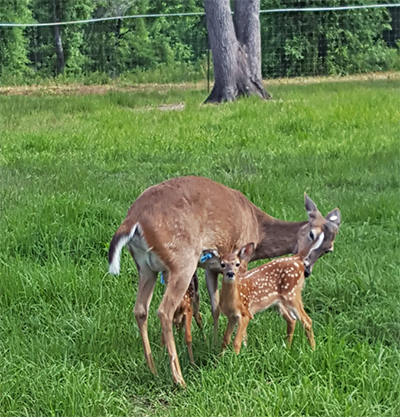 Samantha Wisely, Professor of Wildlife Ecology and Director of the Cervidae Health Research Initiative, Institute of Food and Agricultural Sciences, University of Florida
Samantha Wisely, Professor of Wildlife Ecology and Director of the Cervidae Health Research Initiative, Institute of Food and Agricultural Sciences, University of Florida
With over 70 deer farms in Northwest Florida, the Panhandle provides momentum and leadership to this growing industry in Florida. Deer farms do raise exotic species of deer and antelope for hunting opportunities and venison, but the primary activityi n the Panhandle is raising trophy sized white-tailed deer (Figure 1) for hunting on preserves.
Like any livestock industry, profit margins rely on healthy, productive animals. In Northwest Florida, the primary disease affecting production on deer farms is epizootic hemorrhagic disease (EHD), which causes internal bleeding, pneumonia and death in white-tailed deer, especially fawns. EHD is caused by a virus carried by no-see-um midges. In 2012, an outbreak of this virus caused $32M in losses to Florida deer farmers. In response, the University of Florida created the Cervidae Health Research Initiative.
–
What is the UF/IFAS Cervidae Health Research Initiative?
The Cervidae Health Research Initiative, or CHeRI, is a research/industry partnership between deer farmers in Florida and the University of Florida. Cervidae refers to the scientific name of the family that includes all deer species including elk, fallow deer, axis deer and white-tailed deer – all of which are found on deer farms in the Panhandle. Using the best available science, CHeRI seeks to find solutions to the solve the industry’s greatest challenges to herd health and production. Funding for this initiative comes from the Florida State Legislature, as a result of lobbying efforts from the deer farming industry. After devastating herd losses from epizootic hemorrhagic disease in 2012, Florida deer farmers requested help from the legislature to provide funding for the University of Florida. The result was the introduction of CHeRI in 2015.
–
The Work of UF/IFAS CHeRI
Defining the Viruses that Cause Hemorrhagic Disease
Researchers surveyed deer farmers, which made it clear that hemorrhagic disease was the number one threat to economic sustainability of this industry in Florida. CHeRI’s first priority was to provide a diagnostic service for deer farmers, so that everyone could truly understand what was killing deer in Florida. UF scientists learned that deer throughout the Panhandle were affected by this disease, and about half of all deaths were attributable to EHD (Figure 2). CHeRI’s diagnostic service helps deer farmers care for sick animals and take preventative measures; it also helps CHeRI scientists develop effective vaccines against viruses. Results from the diagnostic services provided by CHeRI, and the samples provided by deer farmers have changed the way scientists view this disease. While epizootic hemorrhagic disease virus remains the predominant disease that kill deer in Northwest Florida, UF scientists have discovered 6 additional viruses that are closely related, that likely result in a similar hemorrhagic disease in deer. CHeRI has now partnered with several vaccine manufacturers to produce vaccines against these viruses. These vaccines should be a game-changer for this industry.

Figure 2. More than 350 deer farms are present (yellow) in 64 of the 67 counties in Florida. Epizootic hemorrhagic disease (EHD) virus is present (blue) in the Panhandle, as well as in North Central and Central Florida.
–
Integrated Pest Management of No-see-ums
The viruses that cause hemorrhagic disease are transmitted to deer by no-see-um midges. Understanding which species of midge carry the viruses is critically important to developing control and management plans. CHeRI entomologists have discovered which no-see-ums carry the EHD virus in Florida, but they still need to understand which no-see-ums carry the other viruses that cause hemorrhagic disease. The CHeRI No-See-Um Identification Services Project provides farmers experiencing outbreaks with a farm-specific profile of disease causing insects on their farms. The data generated from this project has helped scientists understand the distribution of these insects and identify the ones causing disease.
–
Parasite Resistance to Treatment
Farmed deer can carry worms, helminths and protozoans that reduce the growth potential of deer. Most farmers treat deer for worms regularly, but are these treatments effective? CHeRI researchers are investigating drug resistance in gut parasites of deer.
–
Curious about what else CHeRI does?
The UF IFAS Cervidae Health Research Initiative conducts research on problems affecting farmed deer, provides free disease diagnostic services to Florida deer farmers, and is training the next generation of deer vets and farm managers. To learn more about the science and meet the scientists, visit the CHeRI website, where deer farmers can find out how to submit samples, contact a veterinarian, as well as find publications, videos and fact sheets about deer health.
–
Links to additional resources
-
Facts about wildlife diseases: Hemorrhagic disease in deer
-
Trophy deer farming in Florida
-
North American Deer Farmers Association
-
Southeast Trophy Deer Association
- How Landowners Can Help Gopher Tortoise Conservation in the Florida Panhandle - August 29, 2025
- Armadillo Biology, Management, and Disease in the Panhandle - February 21, 2025
- Crop Damage from Deer in the Panhandle - August 15, 2024

